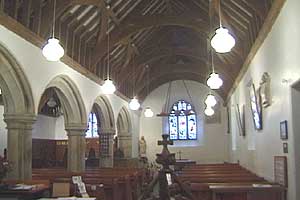

Nissen's inspiration was to render thin, flexible steel sheeting semi-rigid by passing it through a corrugating machine, and then forming the resultant material into a semicircular tube. Only five months passed from the initial concept in April, to production by August. The Nissen hut was invented during World War I, in 1916, by Major Peter Norman Nissen (1871 – 1930), a Canadian mining engineer and officer in the 29th Company Royal Engineers. Although only one monthly service was held for its small congregation, the church building also served as their community hall, and the villagers have commissioned their own structural engineer's report of the building, with a view to saving a resource which would be be greatly missed, as it is the only social facility left in the area since it has already lost its local hotel and shop.

On December 12, 2008, The Dunoon Observer carried the sad news that the Church of Scotland had announced that the Carrick Castle church, which it noted had been built around 1892, was to close as a result of structural problems associated with rotten timber. The Earls of Argyll served as its hereditary keepers. The settlement takes its name from Carrick Castle, once a royal stronghold, which dates from the 15th century and has its remains on a rocky peninsular platform. While the building dates from Victorian times, its history is unknown. Located towards the north end of the small settlement of the small settlement of Carrick Castle on the western shore of Loch Goil, Argyll & Bute, is a corrugated iron church which is still in use by the Church of Scotland (2008). A handsomely designed residence, delivered and erected cost approximately £425. The walls were insulated by a liberal use of felt.
THE TIN CHURCH ISLE OF SEIL FREE
They quote that "sheets of standard Birmingham grade galvanised iron are used, truly and evenly corrugated, thickly coated with pure Silesian spelter, true and even in temper, and free from flaws and cracks." Floorboards were supplied of thoroughly seasoned deal in 1" thicknesses and lining boards in 1/2" tongue and grooved. The construction of these iron buildings was fully detailed in the catalogues. This type of house was normally constructed as secondary accommodation on large estates either for estate workers or overflow accommodation for shooting parties from the main lodge. At the turn of the last century Coopers had an illustrated catalogue of iron buildings (for home and export) of churches, hospitals, club houses, residences, cottages, offices, stables, motor car houses, billiard rooms and ballrooms. It is highly probable that Ballintomb Cottage was delivered in kit form to the local station by William Cooper Ltd of Old Kent Road in London.

The houses were usually purchased as fairly inexpensive kits, able to be erected quickly, and capable of serving the needs of a small community, being available as ready-to-assemble kits for domestic houses, offices, stables, ballrooms, churches and hospitals, as described in the catalogue of one the suppliers of the time, William Cooper Ltd. The original so-called corrugated iron was actually wrought iron, much thicker and robust than the thin, flexible sheet material the term refers to today, and galvanised to resist the weather. In those days, corrugated iron was a more substantial material then the flimsy sheet metal product we know today, and the houses produced then were of significantly better quality than similar structures produced today.
THE TIN CHURCH ISLE OF SEIL PORTABLE
Originally known as portable houses, they first appeared around 1830, but only became widely adopted toward the end of the 19th century. Corrugated iron buildings were once a common sight in the Highlands around the turn of the century, but have now become something of a rarity.


 0 kommentar(er)
0 kommentar(er)
